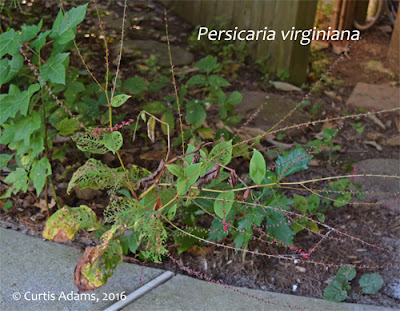Plants from seed
Probably my best result came from seed for rose verbena, Glandularia canadensis. After about 6 weeks of cold stratification I had very good rates germination after a week under lights. I didn't see any plants from direct seeding outside done at the end of February. Either that wasn't long enough or the conditions just were not right. Surpizingly the plants are still leafy green outside (we are on the border of zones 6 and 7).
I also had good results with the annual Texas sage, Salvia coccinea, after a month of cold moist stratification. We also had a lot of these coming up in pots that had been stored in an unheated garage, but none from seed that was left outdoors.
The failure here was with Indian blanket, Gaillardia pulchella. This one germinated during stratification. I planted the sprouted seeds, but they were weak and didn't amount to much, even after being potted up.
 |
| Rose verbena was blooming by mid-July and continued through the summer. |
 |
| This American bellflower is a favorite of native miner bees. |
New Perennials
 |
| The white flowers of wild strawberry are another way to distinguish it from mock strawberry, which has yellow flowers. |
Since I was seeing good results from a hardy cultivated strawberry from the local master gardeners I thought I would try out some of the native species, wild strawberry, Fragaria virginiana. Planted in mid-spring, these small plants settled in enough to put out runners to start new plants a foot or two away. Got some flowers but no fruit this first year. Looks promising as a fruit-bearing ground cover for next year.
 |
| These white woodland phlox, growing in my woodlands are similar to ones I transplanted to under the pines. |
In this same pine-rich area I added more Foamflower, Tiarella cordifolia, and hairy alumroot, Heuchera villosa, as seedlings. In general the Heuchera survive these conditions much better than the Tiarella. It was probably too dry for the young plants to get established. While the Heuchera grow better, they are also more subject to browsing by critters, deer or rabbits of both. Next time I get some Tiarella I'll try it in a moister location, perhaps under a walnut tree.
 |
| The flowers of blunt mountain mint are very attractive to pollinators. |
A new native I added to the garden was blunt mountainmint, Pycnanthemum muticum. I had been trying out hoary mountainmint, P. incanum, for a couple of years. Planted in a partly sunny location, it has been rather slow to grow. I planted the blunt mountainmint in a slightly sunnier location nearby and it grew to about 2' and was covered with dense pinkish flowers. As showy as the flowers are the silvery bracts at the base of each flower.
I have been trying to get some blazing star, Liatris sp., to grow for several years. It seems they get started, then disappear. I'm pretty sure I'm losing them to some small mammals, ground hogs or rabbits. This year I tried plains blazing star, L. squarrosa, with mixed success. The ones planted in the open disappeared, while the ones surrounded by other plants were able to survive. We'll see if these can get established.
 |
| Plains blazing star in bloom. This species has button-like flowers rather than spikes |
New Shrubs
 |
| This gray dogwood managed to bloom before it got pruned back by deer. |
On a disappointing note, only one of the five bare root red cedars, Juniperus virginiana, survived. I have my lone survivor surrounded by chicken wire to protect it from deer. I'll probably need to keep it caged up for a few more years, especially during rutting season.
Now its time to start planning for next year. Let's see, what should I get????


















































